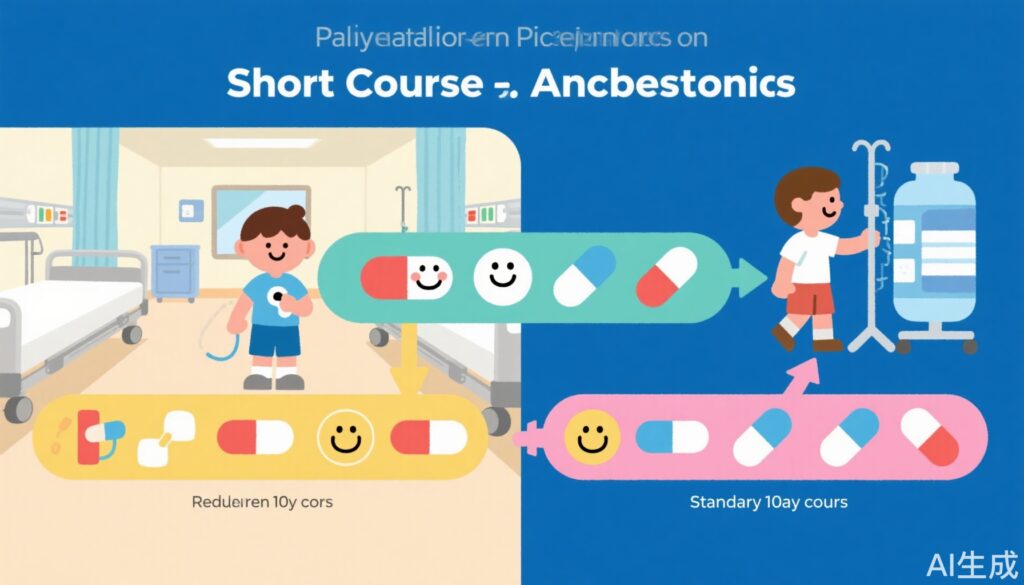Highlights
- Individualised antibiotic therapy for children with febrile urinary tract infection (UTI) led to significantly reduced antibiotic exposure and fewer adverse events compared to the standard 10-day regimen.
- The risk of UTI recurrence within 28 days was higher in the individualised group (11%) than in the standard group (6%), but the absolute difference remained within the pre-defined non-inferiority margin.
- Shorter treatment aligns with antimicrobial stewardship principles, but further research is needed to identify children who truly require longer therapy to avoid recurrence.
Clinical Background and Disease Burden
Urinary tract infection (UTI) is among the most common serious bacterial infections in children, especially in infants and young girls. Febrile UTI, often reflecting pyelonephritis, carries a risk of renal scarring and long-term sequelae if inadequately treated. However, excessive antibiotic use contributes to adverse events, increased healthcare costs, and the global threat of antimicrobial resistance. Despite guideline recommendations, the optimal duration of antibiotic therapy for pediatric febrile UTI remains debated, with standard courses ranging from 7 to 14 days and limited high-quality evidence supporting longer durations. This uncertainty has prompted a need for rigorously designed trials to inform safer, more efficient, and stewardship-aligned clinical practice.
Methodology
The INDI-UTI trial was a pragmatic, open-label, multicentre, randomised, controlled, non-inferiority trial conducted at eight hospitals in Denmark (ClinicalTrials.gov NCT05301023). Eligible participants were children aged 3 months to 12 years presenting with febrile (≥38°C) UTI confirmed by significant growth of uropathogenic bacteria, recruited within 24 hours of treatment initiation. Key exclusions included known urinary tract anomalies, complex medical history, bacteraemia, or impaired renal function.
Participants were randomised (1:1) to:
– Individualised therapy: Antibiotics stopped 3 days after adequate clinical improvement (no fever, flank pain, or dysuria), with a minimum duration of 4 days.
– Standard therapy: Fixed 10-day course of antibiotics.
Primary endpoints were:
– Recurrence of UTI within 28 days post-treatment (non-inferiority margin: 7.5 percentage points)
– Total antibiotic days within 28 days of treatment initiation (superiority assessment)
Safety endpoints included incidence of antibiotic-related adverse events and serious adverse events. Analyses were intention-to-treat.
Key Findings
A total of 408 children were randomised (median age 1.5 years, 80% female). In the individualised group (n=205), the median antibiotic duration was 5.3 days (IQR 4.8–6.5); in the standard group (n=203), it was 10.0 days (IQR 10.0–10.0).
- Recurrent UTI: Occurred in 11% (23/205) of the individualised group versus 6% (12/203) of the standard group (difference 5.3 percentage points; one-sided 97.5% CI –∞ to 11.1; pnon-inferiority=0.24). The difference did not exceed the prespecified non-inferiority margin of 7.5 percentage points, although the upper confidence interval did cross this threshold, making statistical confirmation of non-inferiority uncertain.
- Antibiotic Exposure: Median total antibiotic days were 6.0 (IQR 5.3–7.5) for the individualised group and 10.0 (IQR 10.0–10.0) for the standard group (median difference –4.0 days [97.5% CI –4.5 to –3.7], p<0.0001), demonstrating clear superiority for reduced exposure.
- Adverse Events: Antibiotic-related adverse events occurred at a rate of 6.8 per 100 patient-days in the individualised group versus 11.1 per 100 patient-days in the standard group (rate ratio 0.61 [95% CI 0.47–0.80], p=0.0003). Serious adverse events were similar between groups (8% vs 7%; difference 0.9 percentage points [95% CI –4.6 to 6.5], p=0.79).
Mechanistic Insights and Biological Plausibility
Shortening antibiotic courses when clinical improvement is established is consistent with our understanding of the natural course of bacterial infections and host immune response, particularly in otherwise healthy children. Most bacterial clearance occurs in the early phase of treatment, suggesting that prolonged exposure may offer diminishing returns, while increasing the risk of adverse effects, disruption of the gut microbiome, and selection pressure for resistance.
Expert Commentary
These findings echo the growing consensus in pediatric infectious diseases that shorter antibiotic regimens may suffice for many uncomplicated infections. The modest increase in recurrence risk (5.3 percentage points) must be weighed against the benefits of reduced antibiotic exposure—especially in populations with low baseline risk for serious complications. Current guidelines, such as those from the American Academy of Pediatrics and European Society for Paediatric Nephrology, have not definitively endorsed shorter regimens, citing lack of robust trial data—gaps the INDI-UTI trial begins to address.
Controversies and Limitations
Several limitations warrant consideration:
- Non-inferiority Not Statistically Confirmed: While the observed recurrence rate difference was within the prespecified margin, the upper bound of the confidence interval slightly exceeded the 7.5 percentage point threshold, precluding statistical confirmation of non-inferiority.
- Open-label Design: Lack of blinding may introduce detection or performance biases, although objective endpoints (e.g., recurrence with microbiological confirmation) mitigate some concerns.
- Generalisability: The trial excluded children with urological anomalies, complicated illness, or renal impairment, limiting applicability to these higher-risk groups.
- Short-term Follow-up: Outcomes were assessed at 28 days; longer-term risk of recurrence or renal sequelae was not evaluated.
- No Power Calculation for Antibiotic Days: While superiority was demonstrated for reduced antibiotic use, this was not a powered endpoint.
Conclusion
The INDI-UTI trial provides compelling evidence that individualised, short-duration antibiotic regimens for children with febrile UTI result in substantial reductions in antibiotic exposure and adverse events, with a modest but statistically uncertain increase in early recurrence risk. These results support a shift toward personalised approaches in pediatric UTI management, in alignment with antimicrobial stewardship goals. However, clinicians should remain vigilant for children who may require extended therapy—particularly those with delayed clinical improvement or higher baseline risk. Further studies are needed to refine risk stratification and to assess long-term outcomes.
References
1. Sethi NJ, Carlsen ELM, Tabassum A, et al. Efficacy and safety of individualised versus standard 10-day antibiotic treatment in children with febrile urinary tract infection (INDI-UTI): a pragmatic, open-label, multicentre, randomised, controlled, non-inferiority trial in Denmark. Lancet Infect Dis. 2025 Aug;25(8):925-935. doi: 10.1016/S1473-3099(25)00075-1 IF: 31.0 Q1 .2. Subcommittee on Urinary Tract Infection, Steering Committee on Quality Improvement and Management. Urinary tract infection: clinical practice guideline for the diagnosis and management of the initial UTI in febrile infants and children 2 to 24 months. Pediatrics. 2011;128(3):595-610. doi:10.1542/peds.2011-1330 IF: 6.4 Q1 .3. European Society for Paediatric Nephrology (ESPN) UTI guidelines. Available at: https://www.espn-online.org. Accessed June 2024.


